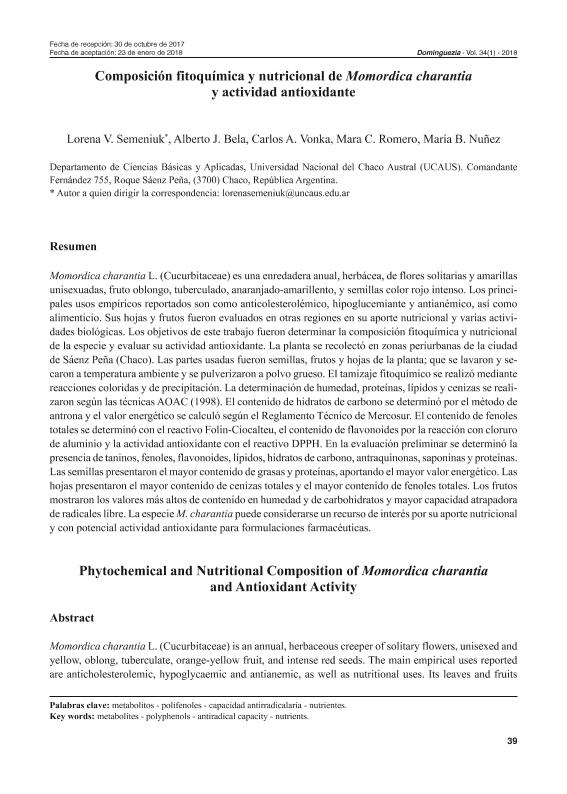Artículo
Momordica charantia L. (Cucurbitaceae) es una enredadera anual, herbácea, de flores solitarias y amarillas unisexuadas, fruto oblongo, tuberculado, anaranjado-amarillento, y semillas color rojo intenso. Los principales usos empíricos reportados son como anticolesterolémico, hipoglucemiante y antianémico, así como alimenticio. Sus hojas y frutos fueron evaluados en otras regiones en su aporte nutricional y varias actividades biológicas. Los objetivos de este trabajo fueron determinar la composición fitoquímica y nutricional de la especie y evaluar su actividad antioxidante. La planta se recolectó en zonas periurbanas de la ciudad de Sáenz Peña (Chaco). Las partes usadas fueron semillas, frutos y hojas de la planta; que se lavaron y secaron a temperatura ambiente y se pulverizaron a polvo grueso. El tamizaje fitoquímico se realizó mediante reacciones coloridas y de precipitación. La determinación de humedad, proteínas, lípidos y cenizas se realizaron según las técnicas AOAC (1998). El contenido de hidratos de carbono se determinó por el método de antrona y el valor energético se calculó según el Reglamento Técnico de Mercosur. El contenido de fenoles totales se determinó con el reactivo Folin-Ciocalteu, el contenido de flavonoides por la reacción con cloruro de aluminio y la actividad antioxidante con el reactivo DPPH. En la evaluación preliminar se determinó la presencia de taninos, fenoles, flavonoides, lípidos, hidratos de carbono, antraquinonas, saponinas y proteínas. Las semillas presentaron el mayor contenido de grasas y proteínas, aportando el mayor valor energético. Las hojas presentaron el mayor contenido de cenizas totales y el mayor contenido de fenoles totales. Los frutos mostraron los valores más altos de contenido en humedad y de carbohidratos y mayor capacidad atrapadora de radicales libre. La especie M. charantia puede considerarse un recurso de interés por su aporte nutricional y con potencial actividad antioxidante para formulaciones farmacéuticas. Momordica charantia L. (Cucurbitaceae) is an annual, herbaceous creeper of solitary flowers, unisexed and yellow, oblong, tuberculate, orange-yellow fruit, and intense red seeds. The main empirical uses reported are anticholesterolemic, hypoglycaemic and antianemic, as well as nutritional uses. Its leaves and fruits were evaluated in other regions of the world in their nutritional contribution and several biological activities. The aims of this work was to determine the nutritional and phytochemical composition of the species and to evaluate its antioxidant activity. The plant was collected in periurban areas of the city of Sáenz Peña (Chaco). The parts used were seeds, fruits and leaves of the plant; which were washed and dried at room temperature and pulverized to thick powder. Phytochemical screening was carried out by means of colorful and precipitation reactions. The determination of humidity, proteins, fats and ashes was performed according to the AOAC techniques. The content of carbohydrates was determined by the anthrone method and the energy values were calculated according to the Mercosur Technical Regulations. The content of total phenols was made with the Folin-Ciocalteu reagent, the flavonoid content by the reaction with aluminum chloride and the antioxidant activity with the DPPH reagent. In the preliminary evaluation, the metabolites tannins, phenols, flavonoids, lipids, carbohydrates, anthraquinones, saponins and proteins were found. The sedes presented the highest content of fats and proteins, providing the highest energy value. The leaves presented the highest content of total ash and the highest content of total phenols. The fruits showed the highest values of moisture and carbohydrate content and higher free radical scavenging capacity. The species M. charantia can be considered a resource of interest for its nutritional contribution and with potential antioxidant activity for pharmaceutical formulations.
Composición fitoquímica y nutricional de momordica charantia y actividad antioxidante
Título:
Phytochemical and nutritional composition of momordica charantia and antioxidant activity
Semeniuk, Lorena Veronica; Bela, Alberto José; Vonka, Carlos Antonio; Romero, Mara Cristina ; Nuñez, María Beatriz
; Nuñez, María Beatriz
 ; Nuñez, María Beatriz
; Nuñez, María Beatriz
Fecha de publicación:
09/2018
Editorial:
Universidad de Buenos Aires. Facultad de Farmacia y Bioquímica. Museo de Farmacobotánica Juan A. Domínguez
Revista:
Dominguezia
ISSN:
1669-6859
Idioma:
Español
Tipo de recurso:
Artículo publicado
Clasificación temática:
Resumen
Palabras clave:
METABÓLITOS
,
POLIFENOLES
,
CAPACIDAD ANTIRRADICALARIA
,
NUTRIENTES
Archivos asociados
Licencia
Identificadores
Colecciones
Articulos(CCT - NORDESTE)
Articulos de CTRO.CIENTIFICO TECNOL.CONICET - NORDESTE
Articulos de CTRO.CIENTIFICO TECNOL.CONICET - NORDESTE
Citación
Semeniuk, Lorena Veronica; Bela, Alberto José; Vonka, Carlos Antonio; Romero, Mara Cristina; Nuñez, María Beatriz; Composición fitoquímica y nutricional de momordica charantia y actividad antioxidante; Universidad de Buenos Aires. Facultad de Farmacia y Bioquímica. Museo de Farmacobotánica Juan A. Domínguez; Dominguezia; 34; 1; 9-2018; 39-44
Compartir



